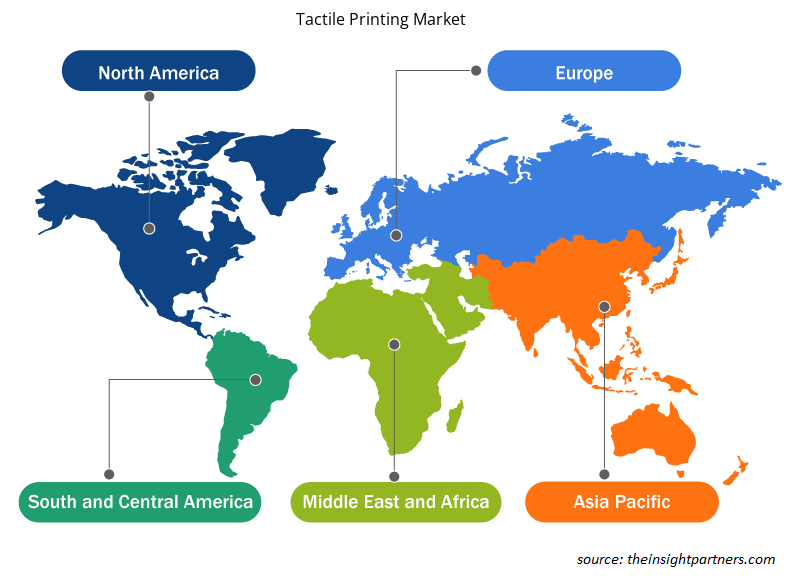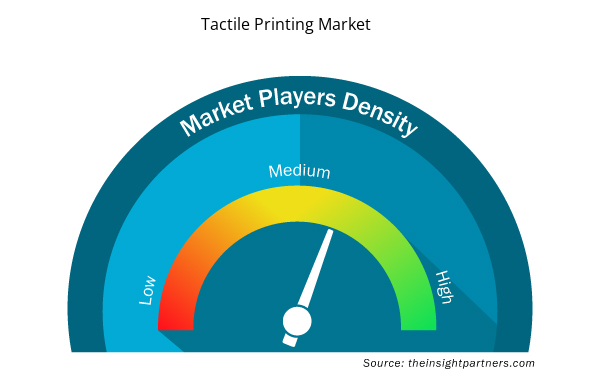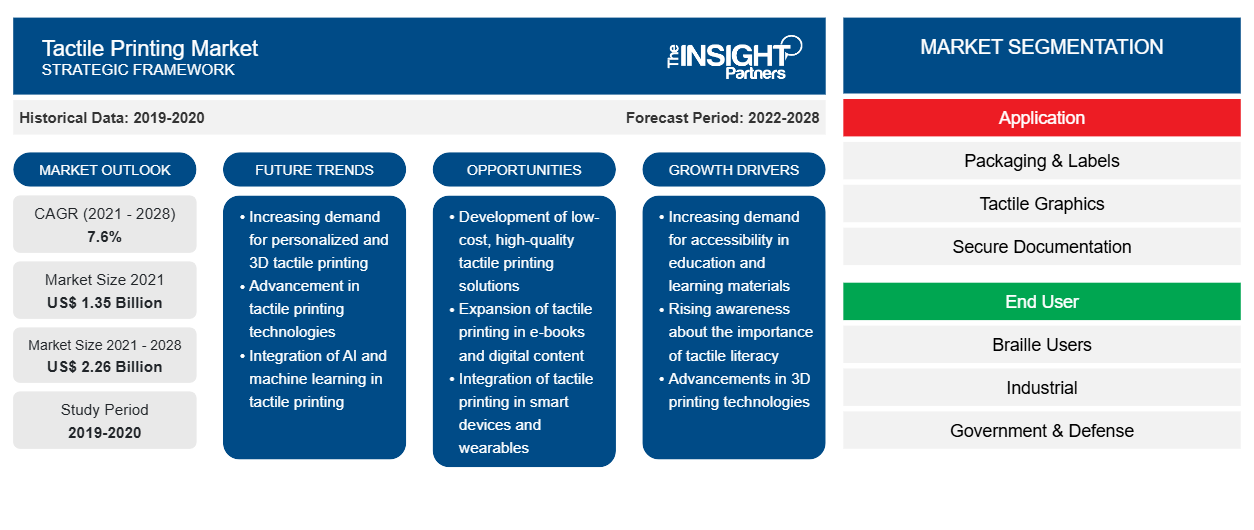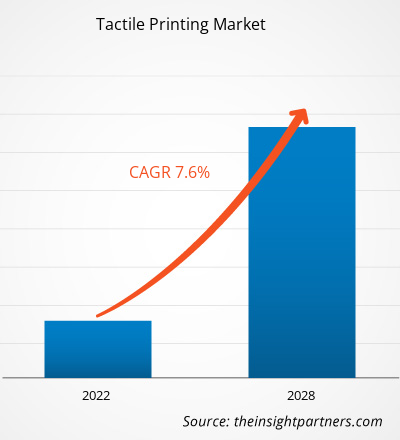Der Markt für taktilen Druck wurde im Jahr 2021 auf 1.353,27 Millionen US-Dollar geschätzt und soll bis 2028 2.257,92 Millionen US-Dollar erreichen; von 2021 bis 2028 wird ein durchschnittliches jährliches Wachstum von 7,6 % erwartet.
Taktiler Druck ist ein Verfahren, bei dem auf einem Druckträger eine Textur erzeugt wird, die durch Berührung wahrgenommen werden kann. Taktiler Druck findet vielfältige Anwendung in der Pharmazie, bei medizinischen Verpackungen, in den Bereichen Humandienstleistungen, Gesundheitswissenschaften, Landwirtschaft, Dienstleistung und anderen Sektoren. Die Nachfrage nach taktilem Druck wird hauptsächlich durch die zunehmende Verwendung dieser Technik in den Bereichen Kartierung, Etikettierung, Verpackung, Sicherheit und sichere Dokumentation getrieben. Darüber hinaus fördern steigende Investitionen in die Braille-Drucktechnologie aufgrund der steigenden Nachfrage nach kundenspezifischen Lösungen wie in Braille gedruckten Spielen, Armbändern, Musikkarten, Anstecknadeln, Schaltern, Visitenkarten, Standortetiketten, Aufklebern, Grußkarten und Taschenrechnern das Wachstum des Marktes für taktilen Druck. Da sich viele Länder darauf konzentrieren, die Beschäftigung sehbehinderter Menschen zu fördern, bietet die Braille-Druckindustrie den Akteuren auf dem Markt für taktilen Druck erhebliche Chancen .
Passen Sie diesen Bericht Ihren Anforderungen an
Sie erhalten kostenlos individuelle Anpassungen an jedem Bericht, einschließlich Teilen dieses Berichts oder einer Analyse auf Länderebene, eines Excel-Datenpakets sowie tolle Angebote und Rabatte für Start-ups und Universitäten.
- Holen Sie sich die wichtigsten Markttrends aus diesem Bericht.Dieses KOSTENLOSE Beispiel umfasst eine Datenanalyse von Markttrends bis hin zu Schätzungen und Prognosen.
Auswirkungen der COVID-19-Pandemie auf den Markt für taktilen Druck
Aufgrund der Störungen bei Angebot und Nachfrage entlang der gesamten Wertschöpfungskette verzeichnen Unternehmen, die auf dem globalen Markt für taktiles Drucken tätig sind, einen Rückgang bei Umsatz und Geschäftswachstum. Daher hat der Ausbruch das Gesamtwachstum des Marktes im Jahr 2020 in gewissem Maße gebremst. Aufgrund des erwarteten Anstiegs der Nachfrage von gewerblichen und industriellen Anwendern weltweit wird jedoch erwartet, dass sich das Marktwachstum ab dem dritten Quartal 2021 normalisiert und von 2021 bis 2028 weiterhin stetig wächst.
Einblicke in den Markt für taktilen Druck
Wachsende Nachfrage nach taktilen Grafiken zur Unterstützung sehbehinderter Menschen
Arbeitgeber in kleinen und mittleren Unternehmen bieten einem breiten Spektrum an Bewerbern Beschäftigungsmöglichkeiten und nehmen auch körperlich behinderte Bewerber in die Belegschaft auf. Daher werden in Branchen wie Marketing, Unternehmensführung und -verwaltung, Humandienstleistungen, Gesundheitswissenschaften und Landwirtschaft in großem Umfang sehbehinderte Bewerber eingestellt. Zu den weiteren Branchen, in denen sehbehinderte Menschen beschäftigt werden, gehören gemeinnützige Organisationen, lokale, staatliche und bundesstaatliche Behörden sowie selbstständige Unternehmer. Gesetzesänderungen und Bürgerrechtsgesetze wirken sich ebenfalls positiv auf die Karrierechancen sehbehinderter Menschen aus. Daher besteht eine hohe Nachfrage nach taktilen Hinweisschildern und Karten, um diese Menschen am Arbeitsplatz zu unterstützen.
Anwendungsbasierte Markteinblicke
Basierend auf der Anwendung ist der Markt für taktilen Druck in Verpackungen und Etiketten, taktile Grafiken und sichere Dokumentation unterteilt. Das Segment Verpackungen und Etiketten war im Jahr 2020 marktführend. Taktiler Druck findet eine wichtige Anwendung in Verpackungs- und Etikettiervorgängen in verschiedenen Branchen, was Unternehmen dabei hilft, eine breitere Kundenbasis zu erreichen. Taktil bedruckte Verpackungsmaterialien und Etiketten helfen auch sehbehinderten Menschen. Darüber hinaus hilft der Einsatz von taktilem Druck den Marken bei der trendigen Präsentation und dekorativen Verschönerung von Verpackungen und bietet Barriere- und andere besondere Funktionen.
Die Akteure im
taktiler Druck
Der Markt wendet Strategien wie Fusionen, Übernahmen und Marktinitiativen an, um seine Position auf dem Markt zu behaupten. Nachfolgend sind einige Entwicklungen der wichtigsten Akteure aufgeführt:
- Im Jahr 2020 führte ViewPlus Technologies Inc. den stärksten und am besten lesbaren Braille-Punkt aller Desktop-Braille-Drucker ein und behielt mit der jetzt verfügbaren Power-Dot-Braille eine ansprechende, abgerundete Punktform bei. Der VP Delta 2 und der VP Columbia 2 prägen weiterhin hochauflösende taktile Grafiken und Braille der Library of Congress (LOC).
- Im Jahr 2021 kündigte die Roland DGA Corporation die Markteinführung von VersaUV LEC2-640 und LEC2-330 an, UV-Drucker/Schneideplotter der nächsten Generation, die speziell dafür entwickelt wurden, die Produktion von Etiketten, Verpackungen, Schildern, Displays und Innendekorationen auf ein neues Niveau zu heben.
Regionale Einblicke in den Markt für taktilen Druck
Die regionalen Trends und Faktoren, die den Markt für taktiles Drucken im gesamten Prognosezeitraum beeinflussen, wurden von den Analysten von Insight Partners ausführlich erläutert. In diesem Abschnitt werden auch die Marktsegmente und die Geografie des taktilen Druckens in Nordamerika, Europa, im asiatisch-pazifischen Raum, im Nahen Osten und Afrika sowie in Süd- und Mittelamerika erörtert.

- Erhalten Sie regionale Daten zum Markt für taktilen Druck
Umfang des Marktberichts zum taktilen Druck
| Berichtsattribut | Details |
|---|---|
| Marktgröße im Jahr 2021 | 1,35 Milliarden US-Dollar |
| Marktgröße bis 2028 | 2,26 Milliarden US-Dollar |
| Globale CAGR (2021 - 2028) | 7,6 % |
| Historische Daten | 2019-2020 |
| Prognosezeitraum | 2022–2028 |
| Abgedeckte Segmente | Nach Anwendung
|
| Abgedeckte Regionen und Länder | Nordamerika
|
| Marktführer und wichtige Unternehmensprofile |
|
Marktteilnehmerdichte: Der Einfluss auf die Geschäftsdynamik
Der Markt für taktiles Drucken wächst rasant, angetrieben von der steigenden Nachfrage der Endnutzer aufgrund von Faktoren wie sich entwickelnden Verbraucherpräferenzen, technologischen Fortschritten und einem größeren Bewusstsein für die Vorteile des Produkts. Mit steigender Nachfrage erweitern Unternehmen ihr Angebot, entwickeln Innovationen, um die Bedürfnisse der Verbraucher zu erfüllen, und nutzen neue Trends, was das Marktwachstum weiter ankurbelt.
Die Marktteilnehmerdichte bezieht sich auf die Verteilung von Firmen oder Unternehmen, die in einem bestimmten Markt oder einer bestimmten Branche tätig sind. Sie gibt an, wie viele Wettbewerber (Marktteilnehmer) in einem bestimmten Marktraum im Verhältnis zu seiner Größe oder seinem gesamten Marktwert präsent sind.
Die wichtigsten auf dem Markt für taktilen Druck tätigen Unternehmen sind:
- Altix
- Konica Minolta, Inc.
- Druckerei Rink
- Sturdy Print & Design Ltd
- American Thermoform
Haftungsausschluss : Die oben aufgeführten Unternehmen sind nicht in einer bestimmten Reihenfolge aufgeführt.

- Überblick über die wichtigsten Akteure auf dem Markt für taktilen Druck
Der Markt für taktilen Druck wurde wie folgt segmentiert:
Markt für taktilen Druck – nach Anwendung
- Verpackung & Etiketten
- Taktile Grafiken
- Sichere Dokumentation
Markt für taktilen Druck – nach Endbenutzer
- Braille-Benutzer
- Industrie
- Regierung und Verteidigung
Markt für taktilen Druck – nach Geografie
Nordamerika
- UNS
- Kanada
- Mexiko
Europa
- Deutschland
- Frankreich
- Italien
- Vereinigtes Königreich
- Russland
- Restliches Europa
Asien-Pazifik (APAC)
- Australien
- China
- Indien
- Japan
- Südkorea
- Restlicher Asien-Pazifik-Raum
Naher Osten und Afrika (MEA)
- Südafrika
- Saudi-Arabien
- Vereinigte Arabische Emirate
- Rest von MEA
Südamerika (SAM)
- Brasilien
- Argentinien
- Rest von SAM
Firmenprofile
- Altix
- Konica Minolta, Inc.
- Druckerei Rink
- Sturdy Print & Design Ltd
- American Thermoform
- Canon Inc
- Index Braille
- Kanematsu USA
- ViewPlus Technologies Inc
- Roland DG Corporation
- Historische Analyse (2 Jahre), Basisjahr, Prognose (7 Jahre) mit CAGR
- PEST- und SWOT-Analyse
- Marktgröße Wert/Volumen – Global, Regional, Land
- Branche und Wettbewerbsumfeld
- Excel-Datensatz



Report Coverage
Revenue forecast, Company Analysis, Industry landscape, Growth factors, and Trends

Segment Covered
This text is related
to segments covered.

Regional Scope
North America, Europe, Asia Pacific, Middle East & Africa, South & Central America

Country Scope
This text is related
to country scope.
Häufig gestellte Fragen
The tactile printing market by application has been segmented into packaging and labels, tactile graphics, and secure documentation. The packaging and labels segment led the tactile printing market with a market share of more than 60% in 2020.
The demand for tactile printing is being majorly driven by the growing use of this technique in mapping, labeling, packaging, security, and secure documentation. Further, increasing investments in the Braille printing technology due to the escalating demand for customized solutions such as Braille printed games, wristbands, musical cards, pins, switches, visiting cards, location labels, stickers, greeting cards, and calculators is augmenting the market growth. With many countries focusing on encouraging the employment of visually impaired people, the Braille printing industry is presenting significant opportunities to the tactile printing market players.
APAC led the global tactile printing market with a revenue share of more than 30% in 2020.The dominance of the region is attributed to the rise in demand for tactile printing in the automotive, chemicals, cosmetics, and health and beauty industries, among others. Increasing awareness about hygiene and transforming lifestyle of consumers, leading to high preference for contamination-free food, in countries such as India, China, and Indonesia have stimulated developments in packaging inks and coating materials in APAC. Moreover, high pace of industrialization and urbanization is fuelling the adoption of tactile printing technology in the region.
Trends and growth analysis reports related to Electronics and Semiconductor : READ MORE..
The List of Companies - Tactile Printing Market
- Altix
- Konica Minolta, Inc.
- Rink Printing Company
- Sturdy Print & Design Ltd
- American Thermoform
- Canon Inc
- Index Braille
- Kanematsu USA
- ViewPlus Technologies Inc
- Roland DG Corporation
The Insight Partners performs research in 4 major stages: Data Collection & Secondary Research, Primary Research, Data Analysis and Data Triangulation & Final Review.
- Data Collection and Secondary Research:
As a market research and consulting firm operating from a decade, we have published and advised several client across the globe. First step for any study will start with an assessment of currently available data and insights from existing reports. Further, historical and current market information is collected from Investor Presentations, Annual Reports, SEC Filings, etc., and other information related to company’s performance and market positioning are gathered from Paid Databases (Factiva, Hoovers, and Reuters) and various other publications available in public domain.
Several associations trade associates, technical forums, institutes, societies and organization are accessed to gain technical as well as market related insights through their publications such as research papers, blogs and press releases related to the studies are referred to get cues about the market. Further, white papers, journals, magazines, and other news articles published in last 3 years are scrutinized and analyzed to understand the current market trends.
- Primary Research:
The primarily interview analysis comprise of data obtained from industry participants interview and answers to survey questions gathered by in-house primary team.
For primary research, interviews are conducted with industry experts/CEOs/Marketing Managers/VPs/Subject Matter Experts from both demand and supply side to get a 360-degree view of the market. The primary team conducts several interviews based on the complexity of the markets to understand the various market trends and dynamics which makes research more credible and precise.
A typical research interview fulfils the following functions:
- Provides first-hand information on the market size, market trends, growth trends, competitive landscape, and outlook
- Validates and strengthens in-house secondary research findings
- Develops the analysis team’s expertise and market understanding
Primary research involves email interactions and telephone interviews for each market, category, segment, and sub-segment across geographies. The participants who typically take part in such a process include, but are not limited to:
- Industry participants: VPs, business development managers, market intelligence managers and national sales managers
- Outside experts: Valuation experts, research analysts and key opinion leaders specializing in the electronics and semiconductor industry.
Below is the breakup of our primary respondents by company, designation, and region:

Once we receive the confirmation from primary research sources or primary respondents, we finalize the base year market estimation and forecast the data as per the macroeconomic and microeconomic factors assessed during data collection.
- Data Analysis:
Once data is validated through both secondary as well as primary respondents, we finalize the market estimations by hypothesis formulation and factor analysis at regional and country level.
- Macro-Economic Factor Analysis:
We analyse macroeconomic indicators such the gross domestic product (GDP), increase in the demand for goods and services across industries, technological advancement, regional economic growth, governmental policies, the influence of COVID-19, PEST analysis, and other aspects. This analysis aids in setting benchmarks for various nations/regions and approximating market splits. Additionally, the general trend of the aforementioned components aid in determining the market's development possibilities.
- Country Level Data:
Various factors that are especially aligned to the country are taken into account to determine the market size for a certain area and country, including the presence of vendors, such as headquarters and offices, the country's GDP, demand patterns, and industry growth. To comprehend the market dynamics for the nation, a number of growth variables, inhibitors, application areas, and current market trends are researched. The aforementioned elements aid in determining the country's overall market's growth potential.
- Company Profile:
The “Table of Contents” is formulated by listing and analyzing more than 25 - 30 companies operating in the market ecosystem across geographies. However, we profile only 10 companies as a standard practice in our syndicate reports. These 10 companies comprise leading, emerging, and regional players. Nonetheless, our analysis is not restricted to the 10 listed companies, we also analyze other companies present in the market to develop a holistic view and understand the prevailing trends. The “Company Profiles” section in the report covers key facts, business description, products & services, financial information, SWOT analysis, and key developments. The financial information presented is extracted from the annual reports and official documents of the publicly listed companies. Upon collecting the information for the sections of respective companies, we verify them via various primary sources and then compile the data in respective company profiles. The company level information helps us in deriving the base number as well as in forecasting the market size.
- Developing Base Number:
Aggregation of sales statistics (2020-2022) and macro-economic factor, and other secondary and primary research insights are utilized to arrive at base number and related market shares for 2022. The data gaps are identified in this step and relevant market data is analyzed, collected from paid primary interviews or databases. On finalizing the base year market size, forecasts are developed on the basis of macro-economic, industry and market growth factors and company level analysis.
- Data Triangulation and Final Review:
The market findings and base year market size calculations are validated from supply as well as demand side. Demand side validations are based on macro-economic factor analysis and benchmarks for respective regions and countries. In case of supply side validations, revenues of major companies are estimated (in case not available) based on industry benchmark, approximate number of employees, product portfolio, and primary interviews revenues are gathered. Further revenue from target product/service segment is assessed to avoid overshooting of market statistics. In case of heavy deviations between supply and demand side values, all thes steps are repeated to achieve synchronization.
We follow an iterative model, wherein we share our research findings with Subject Matter Experts (SME’s) and Key Opinion Leaders (KOLs) until consensus view of the market is not formulated – this model negates any drastic deviation in the opinions of experts. Only validated and universally acceptable research findings are quoted in our reports.
We have important check points that we use to validate our research findings – which we call – data triangulation, where we validate the information, we generate from secondary sources with primary interviews and then we re-validate with our internal data bases and Subject matter experts. This comprehensive model enables us to deliver high quality, reliable data in shortest possible time.


 Holen Sie sich ein kostenloses Muster für diesen Bericht
Holen Sie sich ein kostenloses Muster für diesen Bericht